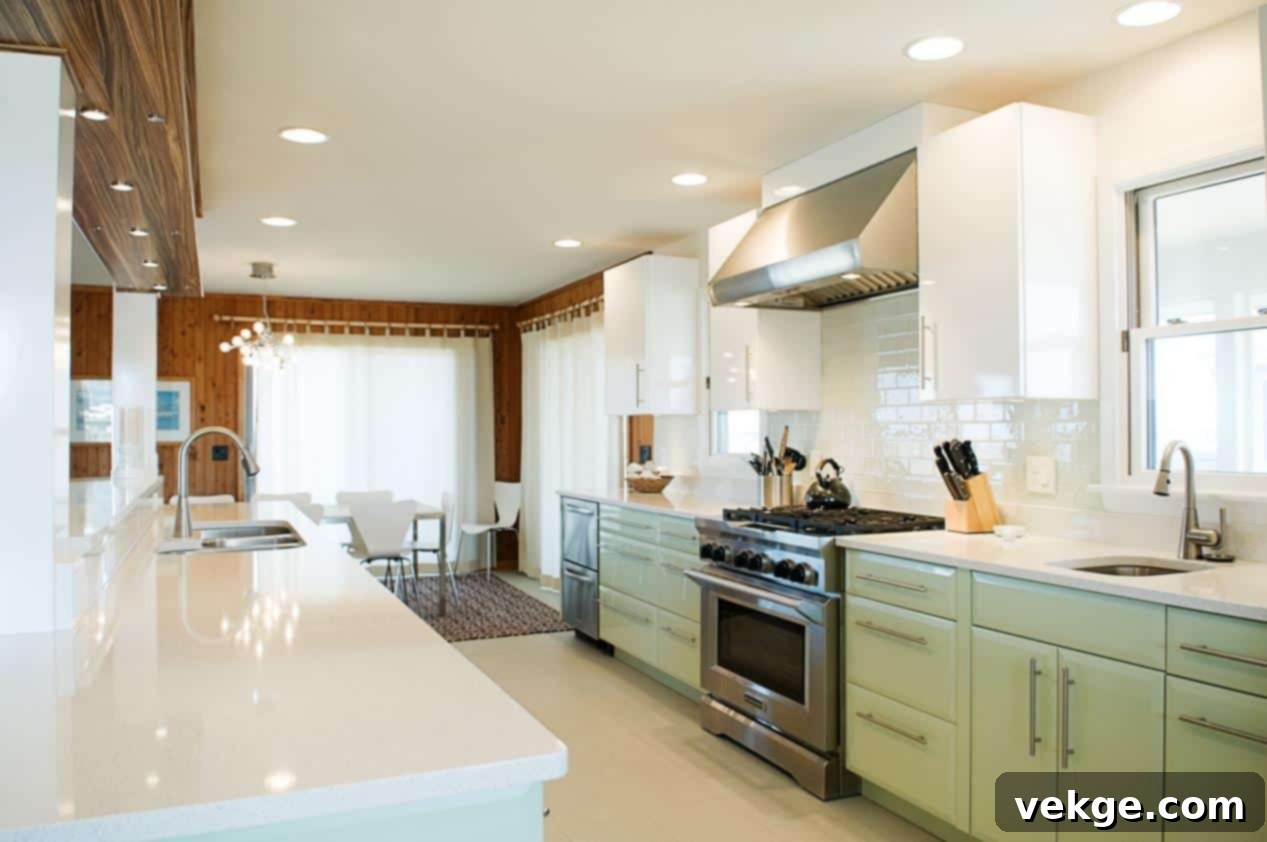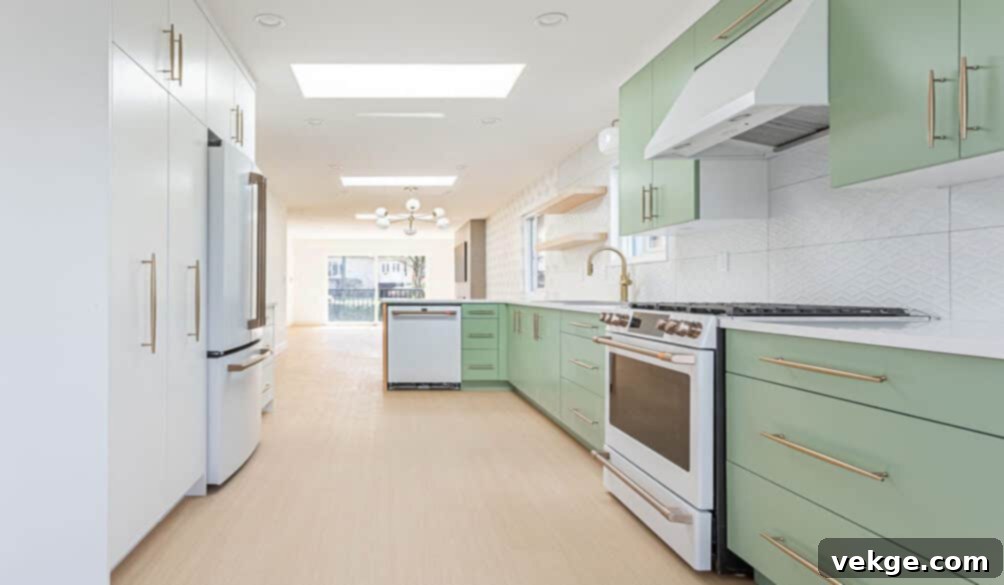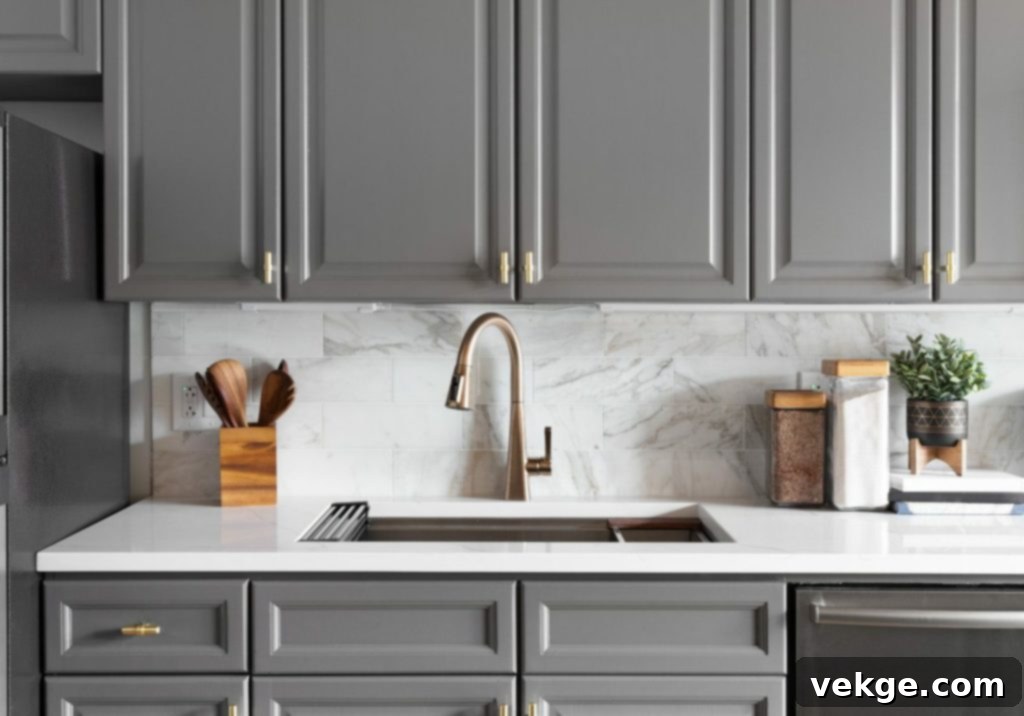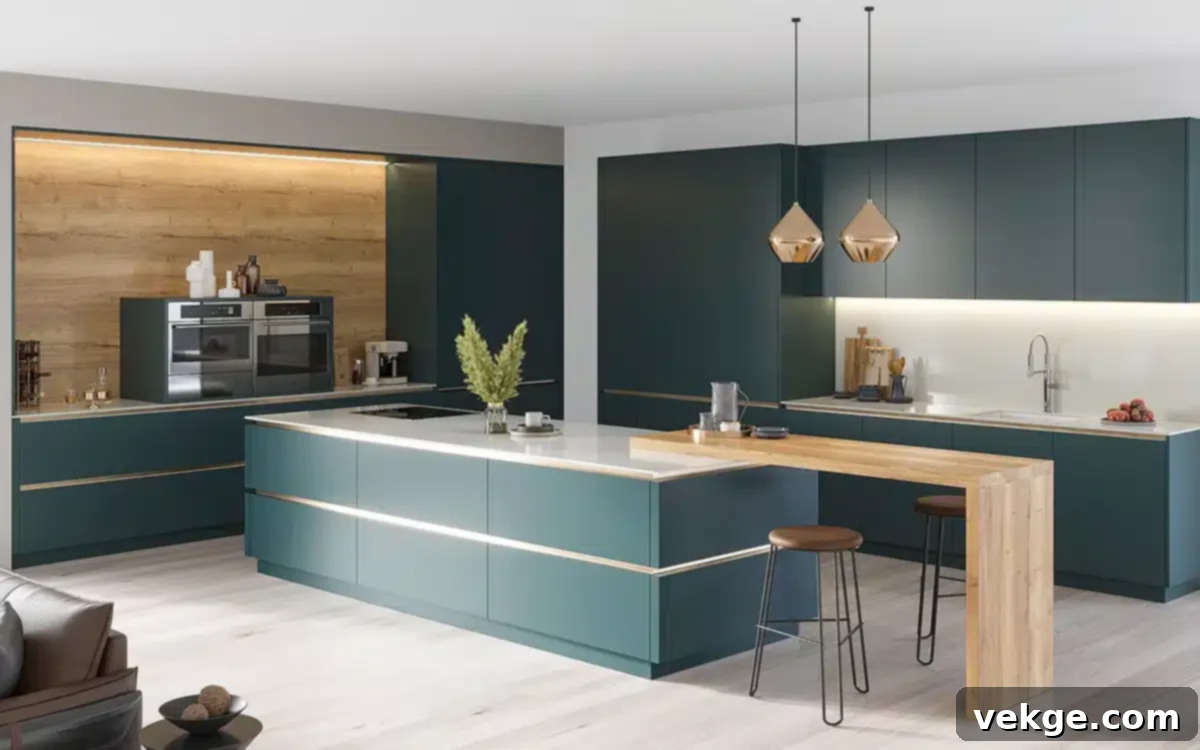Unlocking Your Kitchen’s Mood: A Guide to Cabinet Colors and Color Psychology for Stunning Design
The kitchen, often hailed as the true heart of any home, serves as more than just a place for culinary creations. It’s a bustling hub for family gatherings, a quiet corner for morning coffee, and a vibrant stage for entertaining guests. Given its multifaceted role, the aesthetic and emotional atmosphere of this space are paramount. One of the most impactful decisions in kitchen design involves selecting the right cabinet colors, a choice deeply influenced by the principles of color psychology.
Color psychology explores the profound ways in which different hues can affect human emotions, moods, and even behaviors. In interior design, particularly in a high-traffic area like the kitchen, understanding these psychological impacts can transform a room from merely functional to truly inspiring and comforting. This comprehensive guide will navigate you through leveraging color psychology to choose kitchen cabinet colors that not only look stunning but also enhance the overall ambiance and functionality of your space.
The Foundational Principles of Color Psychology in Home Design
Color psychology is an intriguing field that studies how colors influence human emotions and behaviors. Within interior design, this discipline moves beyond simple aesthetics, evolving into a strategic tool for crafting a specific ambiance within a space. For the kitchen, a room central to daily life and often the social epicenter of the home, the significance of color selection is amplified.
A thoughtfully chosen palette can do more than just elevate visual appeal; it can actively boost a kitchen’s functionality, foster specific emotional responses, and even influence appetite and conversation. By understanding the inherent messages colors convey, homeowners can design kitchens that resonate deeply with their desired lifestyle and personality.
When embarking on a kitchen makeover or planning a new design, integrating pre-assembled kitchen cabinets offers a smart and convenient solution. These cabinets are available in a vast array of colors, finishes, and styles, empowering homeowners to effortlessly select options that perfectly align with their envisioned mood and theme for the kitchen. Their ready-to-install nature simplifies the renovation process, allowing for quicker transformations and less disruption.
For instance, warm tones like vibrant reds, sunny yellows, and earthy oranges are widely known for their ability to stimulate appetite, foster a sense of welcoming warmth, and inject energy into a room. These hues are excellent choices for creating a lively, energetic kitchen that encourages social interaction and joyful culinary adventures. Conversely, cooler hues such as serene blues and calming greens tend to evoke feelings of tranquility, cleanliness, and spaciousness. They are ideal for cultivating a serene and inviting environment, perfect for peaceful mornings or unwinding after a long day.

Understanding the Kitchen’s Dynamic Role in the Modern Home
Far from being just a utilitarian space for preparing meals, the kitchen has evolved into a dynamic epicenter of family life. It transforms seamlessly from a practical food prep area into a vibrant center for family meetings, a lively stage for entertaining friends, a cozy nook for daily routines, and even a quiet retreat for creative culinary exploration. This multifaceted utility underscores the critical importance of selecting cabinet colors that go beyond mere personal style; they must harmoniously support the kitchen’s diverse functions, amplifying its inviting and adaptable ambiance.
When choosing the perfect color for your kitchen cabinets, it’s essential to consider the space’s overall aesthetic and the specific mood you aim to cultivate. Soft, neutral tones such as crisp whites, gentle beiges, and subtle light grays are renowned for making a kitchen feel more expansive and airy. These colors promote a profound sense of calm and cleanliness, offering a timeless backdrop that adapts beautifully to any decor style, from sleek minimalist to charming eclectic designs. They also provide versatility, allowing you to easily update your kitchen’s look with accessories and accent colors without a major overhaul.
Conversely, darker hues like sophisticated navy blue, rich deep green, or luxurious burgundy can introduce an undeniable touch of elegance, depth, and drama. These colors make the space feel more intimate and enveloping, creating a cozy atmosphere that encourages lingering conversations and comfortable dining. Darker cabinets are ideal for crafting a dramatic focal point and can be expertly balanced with lighter walls, countertops, and flooring to maintain a sense of spaciousness and prevent the room from feeling too heavy or confined.
The choice of cabinet color also plays a pivotal role in the kitchen’s practical functionality. Light-colored cabinets inherently reflect more light, helping to illuminate the space and making it easier to see and work in. This is particularly advantageous in kitchens with limited natural light, where they can brighten the room and make it feel more welcoming. In contrast, dark-colored cabinets absorb light, potentially requiring more thoughtful and robust lighting solutions—such as under-cabinet lighting, task lighting, and ambient overhead fixtures—to ensure the space remains functional, inviting, and well-lit at all hours.
Furthermore, the color of your kitchen cabinets can significantly influence the perception of the kitchen’s size. Light colors famously expand a room visually, making it appear larger and more open. This effect is a considerable advantage in smaller kitchens or those with a compact layout. Conversely, darker colors tend to make a large kitchen feel more intimate, grounded, and luxurious, transforming vast spaces into cozy, inviting havens.
Beyond aesthetics and perceived size, it’s crucial to consider the profound psychological effects of color. For instance, various shades of blues and greens are often associated with tranquility, health, and nature, making them exceptional choices for a space where wellness, nourishment, and calm are prioritized. These colors can create a soothing environment conducive to healthy cooking and peaceful dining. Warmer tones like cheerful yellows and inviting oranges can stimulate appetite, foster a sense of warmth, happiness, and vivacity, making them ideal for a family-centric kitchen where joy and conviviality are celebrated.
Popular Cabinet Colors and Their Psychological Effects

White Cabinets: Purity, Cleanliness, and Expansiveness
White cabinets, universally synonymous with purity, cleanliness, and simplicity, possess the remarkable power to utterly transform a kitchen. They make any space appear brighter, significantly larger, and undeniably more welcoming. This color choice is particularly advantageous in smaller kitchens, where it masterfully creates an illusion of expanded space, or in any kitchen layout where a crisp, fresh, and pristine look is desired. The unparalleled versatility of white also allows it to effortlessly complement a vast array of design styles, from the sleek and ultra-modern to the warm and traditional farmhouse. This makes white a truly timeless and adaptable option that can gracefully evolve with changing design trends and personal tastes, ensuring long-lasting appeal and resale value.
Blue Cabinets: Calm, Serenity, and Productivity
Blue cabinets, embodying profound calmness and serene tranquility, have the ability to turn the kitchen into a peaceful haven. The soothing presence of blue, available in its myriad shades—from soft, airy pastels to deep, rich navy tones—promotes a wonderfully productive yet peaceful environment. This color is ideal for establishing a focal point in the kitchen that encourages deep relaxation and comfort, making it a perfect backdrop for both the focused art of cooking and the joyful act of socializing. Blue can also evoke a sense of coastal charm or a sophisticated, classic aesthetic depending on the shade and accompanying elements.
Yellow Cabinets: Warmth, Energy, and Cheerfulness
Yellow cabinets radiate an undeniable warmth and vibrant energy, instantly invigorating any kitchen space. Renowned for its cheerful, inviting, and optimistic nature, yellow can stimulate the appetite and is absolutely perfect for creating a bright, sunny kitchen that truly becomes the radiant heart of the home. Whether opting for a soft, buttery hue that whispers coziness or a vibrant lemon shade that bursts with zest, yellow cabinets can significantly lift spirits and provide a welcoming, cheerful atmosphere for both family and friends. It’s an excellent choice for those looking to infuse their kitchen with personality and joy.
Green Cabinets: Growth, Freshness, and Harmony
Green cabinets, mirroring themes of growth, natural freshness, and vitality, introduce an organic, calming element directly into the kitchen. This color has the unique ability to bring a sense of balance and refreshing renewal, reminiscent of the peaceful outdoors. From subdued sage to deep forest or lively olive, the diverse shades of green can create an environment that is both calming and subtly energizing, promoting overall well-being and harmony within the home. Green cabinets are particularly effective in spaces that aspire to be a sanctuary for health, rejuvenation, and a connection to nature, fitting perfectly into natural or organic modern design schemes.
Red Cabinets: Passion, Energy, and Bold Statements
Red cabinets, bursting with unbridled passion and dynamic energy, can create an exceptionally vibrant and dramatic kitchen environment. This bold color choice is known to stimulate the appetite and instantly add a thrilling touch of vibrancy and excitement to any space. Red is an ideal choice for individuals who wish to make a strong, unforgettable design statement and infuse their kitchen with distinct personality and flair. When utilized thoughtfully—perhaps as an accent or balanced with more neutral tones—red cabinets can become the indisputable centerpiece of the home, inspiring creativity, lively conversation, and a sense of warmth.
Gray Cabinets: Sophistication, Balance, and Modernity
Gray cabinets offer a wonderfully neutral yet incredibly versatile backdrop that masterfully balances sophisticated elegance with understated charm. This adaptable color can create a serene, polished, and contemporary look, suitable for an extensive range of design aesthetics, from sleek modern minimalist to cozy rustic chic. Gray’s exceptional ability to seamlessly blend with virtually any other color and material makes it an enduringly popular choice for those seeking a timeless yet utterly contemporary kitchen design. Different shades, from light ash to deep charcoal, can drastically alter the mood, offering endless possibilities for customization.
Black Cabinets: Depth, Elegance, and Dramatic Flair
Black cabinets, signifying profound depth, undeniable elegance, and powerful sophistication, bring a decidedly edgy and luxurious feel to the kitchen. This daring choice instantly adds a layer of luxury and drama, making a striking visual statement that commands attention. Black cabinets perform exceptionally well in larger spaces where they can ground the room, or as part of a compelling contrasting color scheme, expertly paired with lighter colors for balance and visual interest. They are the quintessential choice for creating an upscale, ultra-modern, or industrial look that exudes unparalleled style and refinement, offering a chic, dramatic backdrop for culinary endeavors.
Each distinct cabinet color carries its unique energy and aesthetic, offering endless possibilities for personalization and profound style expression in the kitchen. By carefully considering the emotional and visual impact of these diverse colors, homeowners can meticulously craft a space that not only brilliantly meets their functional needs but also authentically reflects their unique personality and cherished lifestyle.
Choosing the Right Cabinet Color for Your Kitchen: A Holistic Approach

The journey to selecting the ideal cabinet color for your kitchen involves a careful consideration of several key factors. It’s not just about what looks good in a showroom, but how the color will truly live within your home’s unique environment. Here are some essential elements to ponder:
- Natural Light: The amount and direction of natural light in your kitchen dramatically influence how colors appear. A north-facing kitchen might benefit from warmer tones to counteract cooler light, while a south-facing room can handle cooler shades without feeling dim.
- Kitchen Size and Layout: As discussed, lighter colors tend to make smaller kitchens feel more open and airy. In contrast, larger kitchens can successfully incorporate darker, bolder colors to create a cozy, intimate, or dramatic atmosphere without feeling overwhelmed.
- Existing Elements: Consider the colors of your flooring, countertops, backsplash, and wall paint. Your cabinet color should harmonize or create an intentional contrast with these existing features to achieve a cohesive look.
- Overall Home Aesthetic: Your kitchen should flow seamlessly with the rest of your home’s design style, whether it’s modern, traditional, farmhouse, industrial, or bohemian. Cabinet colors should complement this broader aesthetic to maintain consistency.
- Personal Preferences and Lifestyle: Ultimately, the kitchen is your space. Choose colors that genuinely resonate with you and make you feel comfortable and happy. Also, consider your lifestyle – a busy family kitchen might benefit from more forgiving colors than a rarely used, showcase kitchen.
- Maintenance: Lighter colors, especially white, can show dirt, fingerprints, and smudges more readily than darker or mid-tone cabinets. Consider the level of upkeep you’re willing to commit to.
- Long-term Appeal vs. Trends: While it’s fun to incorporate trends, timeless choices often offer better long-term satisfaction and higher resale value. If you love a trendy color, consider using it for an island or accent cabinets rather than all cabinetry.
By thoughtfully balancing current color trends with enduring, timeless choices, you can ensure your kitchen remains stylish, highly functional, and deeply personal over many years. The true art lies in merging the insightful principles of color psychology with your unique individual style, ultimately creating a kitchen that is not only visually stunning but also profoundly emotionally resonant and a joy to inhabit.
The Art of Color Combinations and Contrasts in Kitchen Cabinetry
Achieving a truly dynamic and visually compelling kitchen design often involves moving beyond a single cabinet color. Strategic mixing and matching of cabinet colors, along with the thoughtful introduction of accent colors, play a crucial role in adding dimension, character, and sophisticated visual interest. Here are some popular and effective approaches:
- Combining Light and Dark Shades for Contrast: This classic approach creates a balanced and sophisticated look. For instance, pairing dark lower cabinets (which are more practical for hiding scuffs and wear) with lighter upper cabinets (which help the kitchen feel airy) can create visual interest and a sense of depth. A popular variation is using a darker color for the kitchen island while keeping perimeter cabinets lighter.
- Using Complementary Colors for a Vibrant Effect: Complementary colors, found opposite each other on the color wheel (e.g., blue and orange, red and green), create a high-contrast, energetic, and lively feel. This strategy requires careful execution to avoid overwhelming the space, often working best when one color is dominant and the other is used as a subtle accent.
- Selecting Analogous Colors for a Harmonious Look: Analogous colors are groups of three colors that are next to each other on the color wheel (e.g., blue, blue-green, and green). This creates a serene, cohesive, and sophisticated look with gentle transitions, lending itself well to tranquil and natural-themed kitchens.
- Two-Tone Cabinets: Beyond just light and dark, consider two different colors for upper and lower cabinets, or for specific zones in the kitchen. For example, a pantry wall in one color and the main cooking area in another can define spaces.
- Incorporating Natural Wood Tones: Combining painted cabinets with elements of natural wood (e.g., a wood island, open shelving, or even some natural wood cabinet doors) introduces warmth, texture, and a connection to nature, complementing most color schemes.
Thoughtful color combinations can elevate a kitchen from ordinary to extraordinary, reflecting a homeowner’s personality and creating a truly unique and inviting space.
The Emotional Impact of Thoughtfully Chosen Cabinet Colors
The profound effect of color on our daily lives, emotions, and behaviors is continuously underscored by insights from interior designers and psychologists alike. Real-life examples abundantly highlight how strategic color choices can utterly transform kitchens, significantly influencing mood, enhancing functionality, and dramatically boosting the space’s overall appeal. Imagine a kitchen with crisp white cabinets: it feels bright, clean, and energizing, perfect for a busy family morning. Now visualize a kitchen with deep blue cabinets and brass hardware: it evokes a sense of calm sophistication, ideal for evening entertaining or a peaceful baking session. A kitchen with vibrant yellow cabinets can become a perpetual source of joy and warmth, stimulating creativity and conversation.
These scenarios demonstrate that cabinet colors do more than just fill a space; they actively shape our experiences within it. They can make a compact kitchen feel spacious, a vast kitchen feel intimate, or a dull kitchen feel vibrant. The choice of color influences how we perceive time in the kitchen, how we interact with others, and even our inclination to cook and gather. This reinforces the immense value of thoughtful selection, encouraging homeowners to see their cabinet choices not merely as decorative decisions, but as powerful tools for enhancing their daily well-being and home life.
Final Thoughts and Key Considerations for Your Kitchen Design
In concluding this exploration, the paramount importance of selecting the right cabinet color for your kitchen simply cannot be overstated. This decision is far more than a stylistic preference; it is a critical component that will shape the daily experience and long-term enjoyment of your home’s most vital space. By diligently considering and applying the principles of color psychology, individuals are empowered to make profoundly informed decisions that expertly balance their personal style preferences with the practical and functional needs of their kitchen.
It is absolutely essential to prioritize your personal comfort and ultimate satisfaction above all else. The goal is to craft a space that not only looks appealing but also feels authentically yours—a welcoming haven where you genuinely love to spend time. Experiment with samples, observe how colors change under different lighting conditions throughout the day, and don’t hesitate to seek advice from design professionals. Remember, your kitchen is a reflection of you and your lifestyle, and its colors should echo that sentiment, creating an environment that supports and enhances your well-being.
Conclusion: Crafting Your Dream Kitchen with Color Psychology
This comprehensive exploration has underscored the significant and multifaceted role that color psychology plays in effective kitchen design. By carefully and consciously choosing cabinet colors, homeowners are equipped to create a space that transcends mere aesthetic and functional requirements, actively enhancing their mood, productivity, and overall well-being. The impact of a thoughtfully selected color palette extends beyond visual appeal, influencing the perceived size of the room, its level of illumination, and the emotional resonance it evokes.
We encourage all readers to approach their kitchen cabinet color choices with a fresh, informed perspective, drawing upon the insights shared in this guide. Whether you lean towards the serene calm of blue, the vibrant energy of yellow, or the timeless elegance of white, understanding the psychological underpinnings of each hue will enable you to make decisions that resonate deeply. Embrace the power of color to transform your kitchen into a truly personalized, inviting, and inspiring space that you and your loved ones will cherish for years to come.
